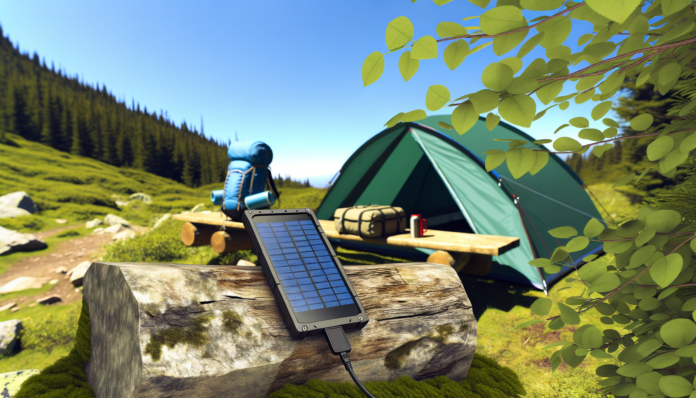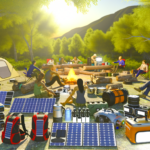Introduction to Solar Chargers
What Are Solar Chargers?
Solar chargers are innovative devices that harness the power of the sun to generate electricity, which can then be used to charge various electronic devices. These chargers typically consist of photovoltaic (PV) cells or solar panels that convert sunlight into electrical energy. The generated electricity can be stored in batteries or used directly to power devices such as smartphones, tablets, cameras, and even small appliances. Solar chargers come in various forms, including portable solar panels, solar power banks, solar backpacks, and integrated solar devices, each designed to cater to different needs and applications.
Benefits of Using Solar Chargers for Outdoor Activities
Solar chargers offer numerous advantages, especially for outdoor enthusiasts. Here are some key benefits:
- Renewable Energy Source: Solar chargers utilize sunlight, a free and abundant renewable energy source, reducing reliance on traditional power sources and fossil fuels.
- Environmentally Friendly: By using solar energy, you reduce your carbon footprint and contribute to environmental conservation.
- Cost Savings: Once you invest in a solar charger, the ongoing cost of generating electricity is virtually zero, leading to long-term savings.
- Off-Grid Power: Solar chargers provide a reliable power source in remote locations where traditional electricity is unavailable, making them ideal for camping, hiking, and other outdoor activities.
- Emergency Preparedness: In case of power outages or emergencies, solar chargers ensure that critical devices like phones, radios, and flashlights remain operational.
- Portability: Many solar chargers are designed to be lightweight and portable, making them easy to carry and use on the go.
Why Solar Chargers Are Ideal for Hiking and Camping Enthusiasts
For hiking and camping enthusiasts, solar chargers are an indispensable tool. Here’s why they are particularly suited for these activities:
- Energy Independence: When you’re out in nature, access to traditional power sources is limited. Solar chargers provide a self-sufficient way to keep your devices charged, ensuring you stay connected and safe.
- Lightweight and Compact: Solar chargers designed for outdoor use are often lightweight and compact, making them easy to pack and carry without adding significant weight to your gear.
- Durability: Many solar chargers are built to withstand harsh outdoor conditions, including water resistance, dustproofing, and impact resistance, ensuring they can handle the rigors of hiking and camping.
- Versatility: Whether you need to charge a smartphone, GPS device, camera, or even a portable refrigerator, solar chargers come in various forms and capacities to meet diverse power needs.
- Eco-Friendly Adventure: Using solar chargers aligns with the principles of Leave No Trace, minimizing your environmental impact while enjoying the great outdoors.
In conclusion, solar chargers are a practical, eco-friendly, and reliable solution for anyone who loves spending time outdoors. They offer the convenience of portable power, ensuring that your adventures are not hindered by a lack of electricity. Whether you’re hiking through remote trails or camping in the wilderness, a solar charger can be your dependable companion, providing the energy you need to stay connected and safe.
Types of Solar Chargers
When it comes to solar chargers, there are several types designed to meet the diverse needs of hiking and camping enthusiasts. Each type has its own set of features, advantages, and ideal use cases. Below, we explore four main types: Portable Solar Panels, Solar Power Banks, Solar Backpacks, and Integrated Solar Devices.
Portable Solar Panels
Portable solar panels are the most common type of solar charger for outdoor activities. These panels are designed to be lightweight, foldable, and easy to carry, making them perfect for hiking and camping.
- Jackery SolarSaga 100: This 100-watt panel is highly efficient, generating 68 Wh in one hour of direct sunlight. It’s user-friendly, folds flat, and weighs just over 10 pounds, making it easy to transport. It includes USB-A, USB-C, and DC outputs, allowing you to charge multiple devices simultaneously.
- BigBlue SolarPowa 28: Known for its efficiency and portability, this 28-watt panel is lightweight and performs well even on cloudy days. It has three USB ports, enabling you to charge several devices at once. It folds up small enough to fit in a backpack, making it ideal for hikers.
- EcoFlow 110: This 110-watt panel is waterproof and lightweight, making it suitable for various weather conditions. It folds four times and comes with a zippered carrying case, making it easy to transport and set up.
Solar Power Banks
Solar power banks combine solar panels with built-in batteries, allowing you to store energy for later use. These are particularly useful for charging devices when sunlight is not available.
- Hiluckey HIS025 25000mAh Power Bank: This power bank features a fold-out four-panel solar array and a large capacity battery. It has two USB-A ports and one USB-C port, making it versatile for charging multiple devices. It’s compact enough to fit in a pocket, making it convenient for on-the-go use.
- Goal Zero Nomad 5: This 5-watt panel is lightweight and comes with an adjustable kickstand for optimal sun exposure. It’s designed to charge small devices directly or store energy in a compatible power bank.
Solar Backpacks
Solar backpacks integrate solar panels into the fabric of the backpack, allowing you to charge devices while you’re on the move. These are ideal for hikers and travelers who need a hands-free charging solution.
- Voltaic Systems Array Solar Backpack: This backpack features a 10-watt solar panel and a 24,000mAh battery pack. It’s designed to charge laptops, tablets, and other small devices. The backpack is made from durable, water-resistant fabric, making it suitable for various outdoor conditions.
- Sunnybag Explorer+: This backpack includes a 6-watt solar panel and a 10,000mAh power bank. It’s lightweight and has multiple compartments for organizing your gear, making it a practical choice for day hikes and short trips.
Integrated Solar Devices
Integrated solar devices are gadgets that come with built-in solar panels. These are typically smaller and designed for specific uses, such as charging a single device or providing light.
- BioLite SolarPanel 10+: This 10-watt panel includes an integrated battery and a built-in sundial for optimal sun alignment. It’s lightweight and compact, making it easy to carry in a backpack. It’s ideal for charging small devices like phones and cameras.
- Goal Zero Lighthouse 600 Lantern: This lantern features a built-in solar panel and a 5200mAh battery. It provides up to 600 lumens of light and can also charge small devices via USB. It’s perfect for camping trips where you need both light and power.
Each type of solar charger has its own set of benefits and is suited for different outdoor scenarios. Whether you need a high-capacity panel for a base camp, a portable power bank for hiking, or an integrated device for specific needs, there’s a solar charger out there to meet your requirements.
Key Features to Look for in a Solar Charger
Portability and Weight
When you’re hiking or camping, every ounce counts. The portability and weight of a solar charger are crucial factors to consider. Look for models that are lightweight and compact, making them easy to carry in your backpack. Foldable designs, like the BigBlue SolarPowa 28, are particularly useful as they can be easily stowed away when not in use. Additionally, integrated handles and carrying cases, such as those found on the Jackery SolarSaga 100, can make transportation even more convenient.
Charging Capacity and Efficiency
The charging capacity and efficiency of a solar charger determine how quickly and effectively it can power your devices. High-wattage models like the Jackery SolarSaga 100 and the EcoFlow 110 are excellent for charging larger devices or multiple gadgets simultaneously. Efficiency is also key; look for solar chargers that perform well in both direct and indirect sunlight. For instance, the BigBlue SolarPowa 28 is known for its impressive efficiency even on cloudy days. Always check the wattage and energy conversion rates to ensure the charger meets your needs.
Durability and Weather Resistance
Outdoor activities expose your gear to various elements, so durability and weather resistance are essential features. Opt for solar chargers made from robust materials that can withstand drops, bumps, and harsh weather conditions. Models like the Renogy 100W Foldable and the EcoFlow 110 are built to be waterproof, ensuring they can handle unexpected rain showers. Additionally, features like sturdy aluminum frames and adjustable legs can enhance the durability and stability of your solar charger.
Compatibility with Devices
A versatile solar charger should be compatible with a wide range of devices. Look for models with multiple output ports, including USB-A, USB-C, and DC outputs, to accommodate different gadgets. The Jackery SolarSaga 100, for example, offers USB-A, USB-C, and DC outputs, making it suitable for charging smartphones, tablets, laptops, and even portable power stations. Some chargers also come with various adapters to ensure compatibility with different brands and models.
Ease of Use and Setup
The ease of use and setup can significantly impact your experience with a solar charger. User-friendly designs with simple setup processes are ideal for outdoor enthusiasts. Features like built-in kickstands, as seen in the Jackery SolarSaga 100, allow you to easily position the panels for optimal sun exposure. Integrated storage for cables and adapters, such as the zipper pockets in the BigBlue SolarPowa 100 ETFE, can also enhance convenience. Additionally, intuitive interfaces and clear instructions can make the setup process quick and hassle-free.
In summary, when choosing a solar charger for your hiking or camping adventures, prioritize portability, charging capacity, durability, compatibility, and ease of use. By considering these key features, you can find a solar charger that meets your needs and ensures you stay powered up on your outdoor excursions.
How to Choose the Right Solar Charger for Your Needs
Choosing the right solar charger for your hiking and camping adventures can be a daunting task given the variety of options available. To make an informed decision, consider the following key factors: assessing your power needs, considering your outdoor activities, budget considerations, and reading reviews and user feedback.
Assessing Your Power Needs
Before purchasing a solar charger, it’s crucial to determine your power requirements. Ask yourself the following questions:
– **What devices will you be charging?** Common devices include smartphones, tablets, GPS units, cameras, and portable power banks.
– **How many devices will you need to charge simultaneously?** Some solar chargers come with multiple USB ports, allowing you to charge several devices at once.
– **How long will you be off-grid?** Longer trips may require a higher capacity solar charger to ensure all your devices remain powered.
For instance, if you only need to charge a smartphone and a GPS unit, a smaller, portable solar charger like the BigBlue SolarPowa 28 might suffice. However, if you need to power multiple devices or larger electronics, a higher wattage option like the Jackery SolarSaga 100 would be more appropriate.
Considering Your Outdoor Activities
The type of outdoor activities you engage in will also influence your choice of solar charger:
– **Hiking:** For hiking, prioritize lightweight and compact solar chargers that can easily fit in your backpack. Models like the X-Dragon 20W are designed to be portable and efficient, making them ideal for on-the-go charging.
– **Camping:** If you’re setting up a base camp, you can afford to carry larger, more powerful solar panels. The Renogy 100W Foldable, with its sturdy build and high efficiency, is perfect for longer stays where you need to power multiple devices.
– **Mixed Activities:** If you engage in both hiking and camping, consider a versatile option like the BioLite Solar Panel 100, which balances portability with sufficient power output.
Budget Considerations
Your budget will play a significant role in determining which solar charger you can afford. Here are some tips to help you make the most of your money:
– **Set a budget range:** Determine how much you’re willing to spend and look for options within that range.
– **Compare features:** More expensive models often come with additional features such as faster charging speeds, higher durability, and multiple charging ports. Weigh these features against your needs to see if they justify the extra cost.
– **Look for value:** Some models, like the BigBlue SolarPowa 100 ETFE, offer great value by combining high performance with affordability.
Reading Reviews and User Feedback
Finally, reading reviews and user feedback can provide valuable insights into the performance and reliability of different solar chargers. Here are some tips for evaluating reviews:
– **Look for detailed reviews:** Reviews that provide specific information about the charger’s performance, durability, and ease of use are more helpful than generic comments.
– **Check multiple sources:** Read reviews from various websites and forums to get a well-rounded understanding of the product.
– **Consider user experiences:** Pay attention to reviews from users who have similar needs and use cases as yours. Their experiences can give you a better idea of how the solar charger will perform in real-world conditions.
By carefully assessing your power needs, considering your outdoor activities, setting a budget, and reading reviews, you can choose the right solar charger that will keep your devices powered throughout your hiking and camping adventures.
Tips for Using Solar Chargers Effectively
Optimal Placement for Maximum Sun Exposure
To get the most out of your solar charger, it’s crucial to place it in a location where it can receive the maximum amount of sunlight. Here are some tips to ensure optimal placement:
- Direct Sunlight: Position your solar charger in direct sunlight, avoiding shaded areas. Even partial shade can significantly reduce the charging efficiency.
- Angle Adjustment: Adjust the angle of the solar panels to face the sun directly. Many solar chargers come with adjustable stands or legs to help you achieve the best angle.
- Track the Sun: If you’re staying in one location for an extended period, move the solar charger periodically to follow the sun’s path across the sky.
- Clear Obstructions: Ensure there are no obstructions like trees, tents, or other equipment blocking the sunlight.
Maintaining and Cleaning Your Solar Charger
Proper maintenance and cleaning can extend the life of your solar charger and ensure it operates at peak efficiency. Follow these steps to keep your charger in top condition:
- Regular Cleaning: Dust, dirt, and debris can accumulate on the surface of the solar panels, reducing their efficiency. Clean the panels regularly with a soft cloth and mild soapy water. Avoid using abrasive materials that could scratch the surface.
- Inspect for Damage: Periodically inspect your solar charger for any signs of wear and tear, such as cracks or loose connections. Address any issues promptly to prevent further damage.
- Store Properly: When not in use, store your solar charger in a cool, dry place. Avoid exposing it to extreme temperatures or moisture, which can damage the components.
Storing and Transporting Your Solar Charger
Proper storage and transportation are essential to protect your solar charger from damage and ensure it remains functional for your outdoor adventures. Here are some tips:
- Use a Protective Case: Many solar chargers come with a protective case or pouch. Use it to prevent scratches and other damage during transport.
- Fold Carefully: If your solar charger is foldable, make sure to fold it carefully along the designated lines. Avoid forcing it into a shape that could damage the panels or connections.
- Secure Cables: Keep all cables and connectors organized and secure. Loose cables can get tangled or damaged during transport.
- Pack Smart: When packing your solar charger with other gear, place it in a location where it won’t be crushed or bent. Consider placing it on top of your backpack or in a side pocket for easy access.
Troubleshooting Common Issues
Even the best solar chargers can encounter issues. Here are some common problems and solutions to help you troubleshoot:
- Slow Charging: If your devices are charging slowly, check the placement of the solar charger. Ensure it’s in direct sunlight and adjust the angle if necessary. Also, clean the panels to remove any dirt or debris.
- No Charging: If your solar charger isn’t charging at all, inspect the connections and cables for any damage. Ensure all connections are secure. If the problem persists, try using a different cable or device to rule out compatibility issues.
- Overheating: Solar chargers can overheat if left in direct sunlight for too long. If you notice your charger getting too hot, move it to a cooler location and allow it to cool down before using it again.
- Intermittent Charging: If the charging is intermittent, check for any loose connections or damaged cables. Also, ensure the solar panels are not partially shaded, as this can cause fluctuations in power output.
By following these tips, you can maximize the efficiency and lifespan of your solar charger, ensuring you have a reliable power source for all your outdoor adventures.
Environmental Impact and Sustainability
Reducing Your Carbon Footprint
For hiking and camping enthusiasts, reducing your carbon footprint is a significant benefit of using solar chargers. Traditional power sources, such as disposable batteries and fuel-powered generators, contribute to environmental degradation through carbon emissions and waste. Solar chargers, on the other hand, harness renewable energy from the sun, providing a clean and sustainable power source. By opting for solar chargers, you minimize your reliance on fossil fuels and reduce the amount of waste generated from disposable batteries. This shift not only helps preserve natural landscapes but also promotes a cleaner, greener planet.
Sustainable Manufacturing Practices
Many manufacturers of solar chargers are committed to sustainable practices, further enhancing the environmental benefits of these devices. These practices include using eco-friendly materials, reducing waste during production, and ensuring ethical labor practices. For instance, some companies use recycled or biodegradable materials in their products, which helps reduce the overall environmental impact. Additionally, sustainable manufacturing often involves energy-efficient production processes and minimal packaging, which further reduces the carbon footprint. By choosing solar chargers from companies that prioritize sustainability, you support a market that values environmental responsibility.
The Future of Solar Technology
The future of solar technology is promising, with continuous advancements aimed at increasing efficiency and accessibility. Innovations such as more efficient photovoltaic cells, flexible solar panels, and integrated solar devices are making solar energy more practical and versatile for outdoor enthusiasts. For example, the development of solar backpacks and solar-powered lanterns allows hikers and campers to charge their devices on the go and illuminate their campsites sustainably. As technology progresses, we can expect solar chargers to become even more efficient, lightweight, and affordable, making them an indispensable part of eco-friendly outdoor gear.
In conclusion, embracing solar chargers for your hiking and camping adventures not only provides a reliable power source but also significantly reduces your environmental impact. By supporting sustainable manufacturing practices and staying informed about advancements in solar technology, you contribute to a more sustainable future.
Conclusion and Final Thoughts
Recap of Key Points
As we conclude our ultimate guide to solar chargers for hiking and camping enthusiasts, let’s recap the key points discussed:
- Introduction to Solar Chargers: We explored what solar chargers are, their benefits for outdoor activities, and why they are ideal for hiking and camping enthusiasts.
- Types of Solar Chargers: We delved into various types, including portable solar panels, solar power banks, solar backpacks, and integrated solar devices.
- Key Features to Look for in a Solar Charger: We highlighted essential features such as portability, charging capacity, durability, compatibility, and ease of use.
- How to Choose the Right Solar Charger for Your Needs: We provided guidance on assessing power needs, considering outdoor activities, budget considerations, and reading reviews.
- Tips for Using Solar Chargers Effectively: We offered practical tips on optimal placement, maintenance, storage, and troubleshooting common issues.
- Environmental Impact and Sustainability: We discussed how solar chargers help reduce carbon footprints, sustainable manufacturing practices, and the future of solar technology.
Encouragement to Embrace Solar Technology
Embracing solar technology is not just a step towards convenience but also a commitment to sustainability. Solar chargers offer a reliable and eco-friendly way to keep your devices powered during outdoor adventures. By harnessing the power of the sun, you can reduce your dependence on traditional power sources and minimize your environmental impact. Whether you’re a seasoned hiker or a casual camper, integrating solar chargers into your gear can enhance your experience and contribute to a greener planet.
Additional Resources and Further Reading
For those interested in diving deeper into the world of solar chargers and sustainable energy, here are some additional resources and further reading:
- U.S. Department of Energy – Solar Energy Technologies Office
- Solar Power World
- National Renewable Energy Laboratory – Solar Research
- Consumer Reports – Solar Panels Buying Guide
- REI Expert Advice – Solar Power
In conclusion, solar chargers are an invaluable addition to any outdoor enthusiast’s toolkit. They provide a sustainable, reliable, and convenient power source that can enhance your hiking and camping experiences. By choosing the right solar charger and using it effectively, you can stay connected, reduce your environmental impact, and enjoy the great outdoors with peace of mind. Happy adventuring!






